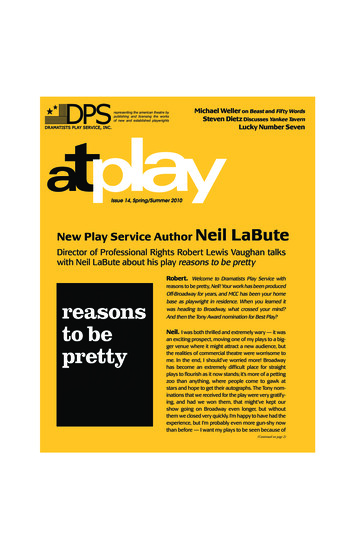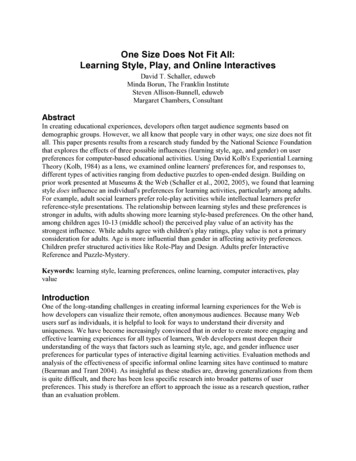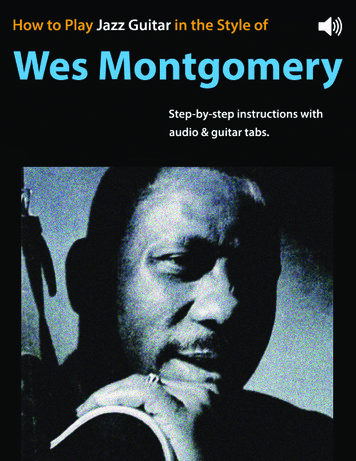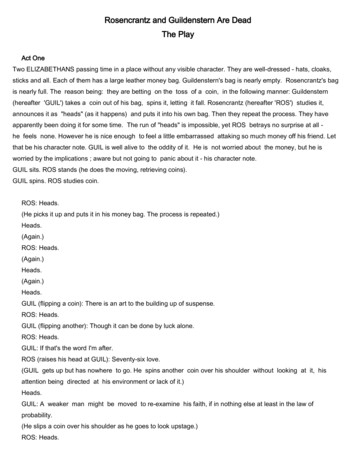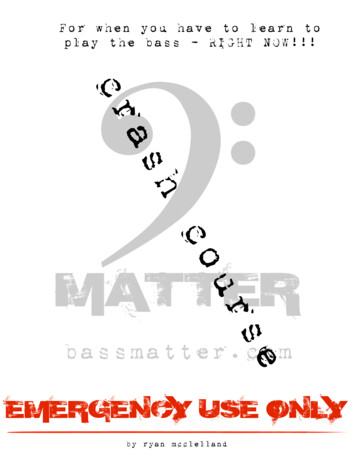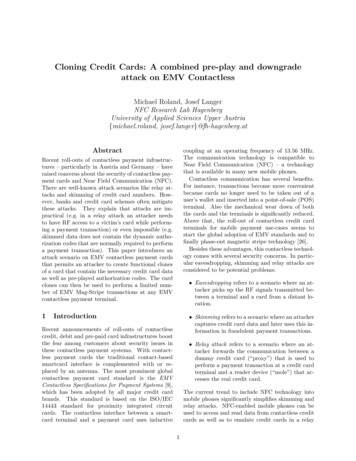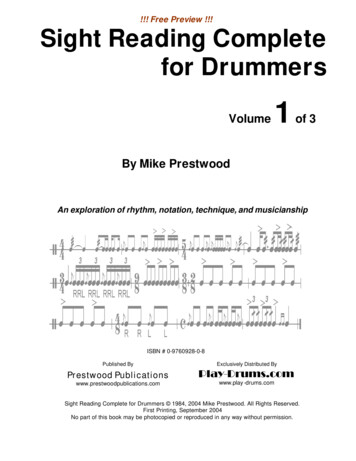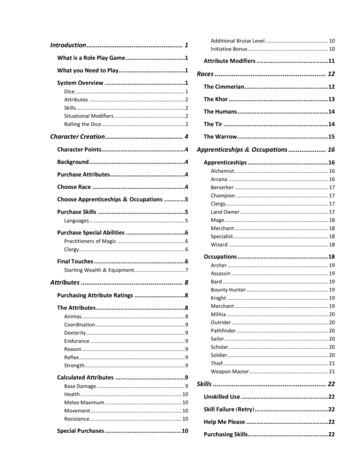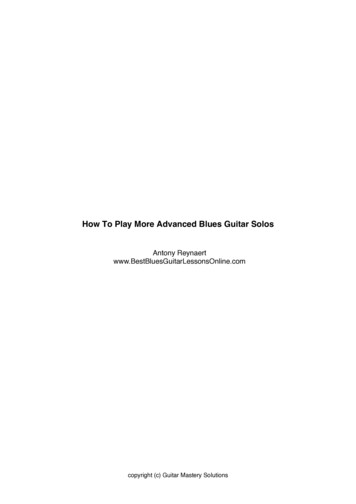
Transcription
How To Play More Advanced Blues Guitar SolosAntony ght (c) Guitar Mastery Solutions
ContentsIntroduction:Why Your Guitar Solos Don’t Come Close To The Solos Of Great Blues GuitaristsI. The Basics: The Minor Pentatonic ScaleA. Why The Minor Pentatonic Scale Is Not The Best Option To Use . . . . . . . . . . .3B. How Professional Blues Guitarists Use The Minor Pentatonic Scale . . . . . . . . 4II. The Basics Part II: The Major Pentatonic ScaleA. How To Use The Major Pentatonic Scale . . . . . . . . . . . . . . . . . . . . . . . . . . . . . 5B. Where To Use The Major Pentatonic Scale . . . . . . . . . . . . . . . . . . . . . . . . . . . 6III. Alternating Between The Minor & Major Pentatonic ScalesA. Abrupt Changes Between The Minor & Major Pentatonic Scale . . . . . . . . . . . . 8B. Creating Fluent Transitions Between The Minor & Major Pentatonic Scale . . . . 9C. Playing The Minor & Major Pentatonic In The Same Position . . . . . . . . . . . . . . 9IV. Going Beyond The Basics: The Dominant Pentatonic ScaleA. The Dominant Pentatonic Scale . . . . . . . . . . . . . . . . . . . . . . . . . . . . . . . . . . . . 11V. Making It Jazzy: The Mixolydian ModeA. Gravitating From Blues to Jazz . . . . . . . . . . . . . . . . . . . . . . . . . . . . . . . . . . . . 12
IntroductionWhy Your Guitar Solos Don’t Come Close To The Solos Of GreatBlues GuitaristsSo you are starting to play your own blues guitar solos. Great! You have ablast of a time improvising. But soon you start comparing yourself to otherguitarists and sooner or later your progress comes to a halt and you findyourself not sounding anything like the guitarists that you listen to. This ishow most guitarists stops progressing, no matter how much they practicetheir progress only seems to take small babysteps. On top of this, the worstthing is that they don’t even know how to improve their guitar playing.While this frustration is shared by many guitarists, there are solutions tothis. Ofcourse there are many reasons why a novice guitarists’ playing willnot sound anything like an experienced guitarist. All of these reasonsshould be addressed seperatly and taken care of in your personal learningand practice plan. But there’s one very prominent reason why your bluesguitar solos don’t sound great; that reason comes down to the exact notesyou play (note choice) and the knowledge of the scales that contain thosenotes.In this guide we will be looking at solutions to overcome these restriction inyour playing by examining the choices that the great blues masters makeand by expanding your knowledge of guitar scales. We’ll start of slowly withthe basics like the pentatonic scales, but soon thereafter we’ll look intomore advanced scales like the dominant pentatonic scale and the jazzysounding mixolydian mode.Mastery of these materials will come through the form of application andimplementation in your practice routine. Simply reading about these optionswill not enable you to transform your guitar playing to the extend that youwill play mature sounding blues solos. So as you delve in to this guide, it’simportant that you have two questions on your mind;-How can I use this in my own playing?-How can I practice this so it becomes part of my own unique style?These simple questions will open the door for you to mature decisionmaking in your practice routine and hold the power to lead you to mastery. Guitar Mastery Solutions, Inc.2
I. The Basics: The Minor Pentatonic ScaleA. Why The Minor Pentatonic Scale Is Not The Best Option To Use58Am Pentatonic Scale (box position)Let’s start with questioning the good old minor pentatonic scale. Manyintermediate guitarists get stuck playing only this scale over a dominantblues. Let me ask you this; “Did you know that the minor pentatonic scaleisn’t the best choice to play over a blues chord progression?” In fact,some notes will even ‘clash’ quite a bit.Spelling Out The NotesWhenever you come across a scale and you want to know if you can usethis scale over a certain chord or series of chords, it’s a great idea tocompare the notes in the scale with the notes that are in the chord(s) thatare being played in the rhythm parts.To analyze this we’re going to spell out the notes in the A minorpentatonic scale, which are:ACDEGHere are the notes in the A7 chord:A C# E GThe C note from the pentatonic scale will sound pretty harsh against theC# note of the A7 chord. You can try this for yourself; play these twonotes simultaneously on the guitar and listen to the dissonance that thiscreates.Ofcourse the minor pentatonic is the first scale to get into if you learn toimprovise, but we want to move away from only playing this scale. Guitar Mastery Solutions, Inc.3
B. How Professional Blues Guitarists Use The Minor Pentatonic ScaleWhile it’s true that some people like the dissonance that is caused byplaying the C-note over the A7 chord, most experienced blues guitarists willchoose to either:- ‐Not use the minor pentatonic scale at all (that’s the main reason why manybeginners on blues guitar improvisation hear that what they play doesn’tsound anything like their favourite players, but they don’t know that theyactually are using different scales).- ‐Use the minor pentatonic scale but alter some of the notes.- ‐Use a variety of techniques to alter the C note (if we play the Am pentatonicscale) so this note becomes a ‘passing note’ instead of a ‘target note’.Don’t get me wrong on this, it’s perfectly legitamite to use the minorpentatonic scale over dominant blues chords. It’s just that there are manymore options and the minor pentatonic scale may be, based on yourpersonal preferences, not the only option that you want to use.In fact there are so many other scales that we can use to solo over a bluesprogression, that it would be a pitty to only use one scale all of the time.Many highly advanced blues guitarists make use of not one single scale,but combine many different scales to make their sound stand out more.Since there are countless options that we can look into, we’ll just focus onthe aforementioned solutions in this guide.The Blues Bend In ActionOne approach we can use is to play the Am pentatonic scale, but usetechniques to alter the C note. For instance, you can bend the C note up tothe C# note using a blues bend. In this way, the C note becomes a ‘passingnote’ instead of a ‘target note’, since we don’t stay on this C note but use itin a way to get to the C# note.The dissonance that will be created by using the C note to resolve to themore stable C# note is something that you can use to your benefit to playout the contrast between minor and major tonality, which is something thatis being used in the playing of a lot of blues guitarists such as B.B. King, Guitar Mastery Solutions, Inc.4
Freddie King, Eric Clapton, Stevie Ray Vaughan and countless others.Look at this example in the tab below; here we are using a blues bend onthe C note to get to the C# note.Listen to this lickII. The Basics Part II: The Major Pentatonic ScaleA. How To Use The Major Pentatonic ScaleNow let’s look at the major pentatonic scale. While most guitarists are awarethat you can also use this scale to improvise over dominant blues chords,many run into trouble when trying to make this scale sound great. Thiscomes from not being aware of the order of the notes in the scale. If you’reused to playing the minor pentatonic scale and try to ‘copy’ your licks,phrases and runs to the major pentatonic scale you’ll find that this doesn’twork well. This is normal, because the notes are positioned differently in theminor pentatonic scale then in the major pentatonic scale. Look at the scalediagram below and notice the position of the root note (the notes which arecircled).25A major pentatonic (box position)58A minor pentatonic scale (box position) Guitar Mastery Solutions, Inc.5
As you can see, even thought the fingerings are the same for both scales,the position of the root notes are different from each scale. So if we wouldplay a minor pentatonic lick that ends on the root note and we try to copy thisexact same lick to the major pentatonic scale we wouldn’t be landing on theroot note anymore, which would make our lick sound totally different (and inmost cases sound ‘wrong’).What you have to do here is to learn that the major pentatonic is a totallydifferent scale then the minor pentatonic scale, with different notes, differentsounds it will produce and a different musical function. Which means thatyou’ll need to start using the major pentatonic scale in a totally different waythen you’re used to using the minor pentatonic scale.B. Where To Use The Major Pentatonic ScaleAlso, knowing where to use the major pentatonic scale is part of thesolution to make this scale work well. I’m not talking about the musicalstyle you can fit this scale in, as you’re probably aware of the importanceof this scale in country-inspired styles (if you want to create a countrysound in your soloing the major pentatonic scale is the way to go).Here we’re talking specifically about over what chords we could use thisscale. First it is important to realize that we can only use the majorpentatonic scale when soloing over a ‘major blues’ (which means we areplaying over a blues progression in a major key with dominant 7th-chords,such as A7, D7 and E7). If we would play over a ‘minor blues’progression (with for instance the chords Am7, Dm7 and Em7) we can’tuse the major pentatonic scale.There are many possibility’s that can be explored and each of them willbring a very unique sound to your playing, but to keep this simple we’llstart of with only playing the major pentatonic scale over the I chord andthe V chord. So if we were playing in the key of A we would be using themajor pentatonic scale over chords A7 and E7. Over the D7 chord we’llshift back to the minor pentatonic scale.If you want to know the reason why this works so well, we’ll need to ‘spellout the notes’ again.- The notes in the A7 chord: A C# E G Guitar Mastery Solutions, Inc.6
Over this A7 chord we play the A major pentatonic scale, which holds thenotes:AC#DEF#As you can see, three of the notes in the chord are also included in thescale, which makes it a perfect fit to play. There’s no clash between theC# note and the C note as it would be when we play the minor pentatonicscale instead of the major pentatonic we’re using here. Let’s also look atthe D7 chord.- The notes in the D7 chord: D F# A COver this D7 chord we play the A minor pentatonic scale, which holds thenotes:ACDEGAgain, notice the corresponding notes that are present in the chord aswell as in the scale.The notes in the E7 chord: E G# B DOver this E7 chord we play the A major pentatonic scale again, whichholds the notes:AC#DEF#There are many other options that can be explored here, but instead ofdiving head first into the complex world (yes, blues isn’t an ‘easy’ style, itcan be quite complex if you want to play it well) of blues scales andchords, let’s stay with this first exercise for now.Now go and play over a 12 bar blues progression in the key of A (you caneither use a backing track or record the chords yourself) and practicesoloing over it using the aforementioned approach. Guitar Mastery Solutions, Inc.7
III. Alternating Between The Minor & Major Pentatonic ScalesA. Abrupt Changes Between The Minor & Major Pentatonic ScaleOne of the options that we can use to add more variation in our blues guitarsoloing is to alternate between the minor pentatonic scale and the majorpentatonic scale.In the scale diagrams below you see both the minor and major pentatonicscale in the key of A. So these scales can be used interchangeably if weplay over a ‘Blues in A’ (the term ‘Blues in A’ is used when we are playing aMajor Blues in the key of A, when we would play a Minor Blues we speak ofa ‘Minor Blues in A’).25A major pentatonic (box position)58A minor pentatonic scale (box position)Now try this: play a solo over a blues in A backing track and switch back and forthbetween these two scales. You will notice that even though this sometimes willresult in a nice sound, sometimes it will be challenging to create a fluent changebetween both scales. The change from the minor pentatonic to the majorpentatonic scale (and vice versa) will often sound to ‘abrupt’. That’s why we’regoing to look at some transitions, which you can use to combine these twoscales.The most common option is to play a lick in the major pentatonic scale and then alick in the minor pentatonic scale, both played in box position. In the examplebelow you see that we start in the A major pentatonic scale (box position) andthen we jump to the A minor pentatonic scale (also in box position). Guitar Mastery Solutions, Inc.8
Listen to this lickC. Creating Fluent Transitions Between The Minor & Major PentatonicScaleIn the example below we start of in the major pentatonic scale and then transitionto the A minor pentatonic scale all within the same lick. Take note of the use ofthe C# note in the second measure of this lick. Because we add this note (thatoriginates from the A major pentatonic scale) to the minor pentatonic scale wecreate a slightly more major pentatonic sound, while shifting focus to the minorpentatonic scale. So in this lick we start of playing the major pentatonic scale andthen use the minor pentatonic scale but with the C# note instead of the C note.Listen to this lickTry to experiment with this way of linking both scales together. Simply startplaying a lick in the major pentatonic scale and try to make the transition to theminor pentatonic scale as smooth as possible. Also work the other way around,start with the minor pentatonic scale and try to shift to the major pentatonic scalefluently.D. Playing The Minor & Major Pentatonic Scale In The Same PositionIn the last blues lick we used both the minor and the major pentatonic scale intheir box positions. We can also choose t
beginners on blues guitar improvisation hear that what they play doesn’t sound anything like their favourite players, but they don’t know that they actually are using different scales). % Use the minor pentatonic scale but alter some of the notes. % Use a variety of techniques to alter the C note (if we play the Am pentatonic scale) so this note becomes a ‘passing note’ instead of a .
